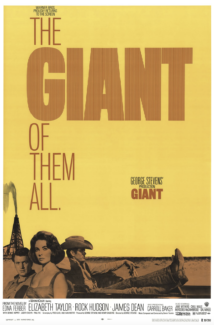Giant (George Stevens, 1956): U.S.A.
Reviewed by Larry Gleeson during the annual TCM 31 Days of Oscar
 Giant (1956) received 10 Oscar nominations with George Stevens taking home the statuette for Best Director. The film, based on his adaptation of Edna Ferber’s 1952 best-selling novel, is three hours and seventeen minutes long following the Benedict family across several generations. Along the way the audience is introduced to cattlemen, roughnecks, the underclass. The Benedicts are Texas royalty. Jordan Benedict (Rock Hudson) referred to as Bick needs a wife and courts Leslie (Liz Taylor). Leslie is an East Coast girl refined, educated, spirited, well-spoken, and attractive. After the two are married they settle at the Reata Ranch – a massive 594,000-acre cattle ranch. A hired hand beloved by Bick’s sister, Jet Rink (James Dean), is bequeathed a small patch of the ranch and strikes oil.
Giant (1956) received 10 Oscar nominations with George Stevens taking home the statuette for Best Director. The film, based on his adaptation of Edna Ferber’s 1952 best-selling novel, is three hours and seventeen minutes long following the Benedict family across several generations. Along the way the audience is introduced to cattlemen, roughnecks, the underclass. The Benedicts are Texas royalty. Jordan Benedict (Rock Hudson) referred to as Bick needs a wife and courts Leslie (Liz Taylor). Leslie is an East Coast girl refined, educated, spirited, well-spoken, and attractive. After the two are married they settle at the Reata Ranch – a massive 594,000-acre cattle ranch. A hired hand beloved by Bick’s sister, Jet Rink (James Dean), is bequeathed a small patch of the ranch and strikes oil.
The narrative covers a lot of ground while keeping centered on these three characters. Dean and Hudson both received nominations for Best Actor in a Leading Role for their work in Giant. Unfortunately, Dean’s nomination was posthumously awarded as he had succumbed to injuries sustained in a fatal car wreck on a rural California highway just days after the film wrapped. While Taylor was not nominated, her entrance at the Benedict ranch with powder blue sundress with matching bow and heels, her blue eyes, and raven black hair, is a spectacle to behold. Taylor maintained of all the roles she had; the role of Leslie Benedict came the closest to matching her off-screen persona.
Stevens attention to detail in Giant is meticulous. William T. Mellor is credited as the Director of Photography. Mellor had won an Oscar for in 1952 for A Place in the Sun and would go on to win second Oscar for in 1960 for The Diary of Anne Frank. Today many cinephiles comment on modern auteur Wes Anderson’s works with his frames being painstakingly shot to photographic perfection. Well, Mellor was Wes Anderson before Wes Anderson became Wes Anderson. But there’s more in Giant. Much more than just the photography. It’s the film’s mise-en-scen with its costuming, it’s set design, the cinematography, the non-diegetic musical score, the pacing, the acting, the narrative, and the continuity editing that make the story come to life.
Giant is not a perfect film by any stretch of the imagination. The characters age with some costuming and hair styles adjustments. Unfortunately, the makeup falls short of the mark. Maybe a nitpick. But while the film’s narrative is engaging, a few of the film’s scenes feel a bit gratuitous. Seeing Jet addressing an empty room, falling forward knocking over an entire row of folding tables and tablecloths before passing out for the second time in one evening seemed a tad unnecessary. Although, it does seem to underscore the ridiculousness of the entire event. Nevertheless, Judy Benedict (Fran Bennett) needed to see what kind of person Jet was in order to move on with her life. As this was James Dean’s capstone, It makes sense to keep it in the final product.
Seeing Rock Hudson, originally typecast to be a matinee idol, James Dean, and Liz Taylor at the top, or near the top, of their career performances is a treat. The entire cast is excellent. The film was made in the Hollywood era of the epic – several of which were nominated for Best Picture in 1956, including The Ten Commandments, The King and I, and Around the World in Eight Days (winner). In addition, Stevens chose to use IB Technicolor, a specific type of Technicolor print known for its longevity and high color stability prints. While Giant was made nearly seventy years ago, it is still an epic telling of Texan history. Highly recommended.
About this entry
You’re currently reading “Giant (George Stevens, 1956): U.S.A.,” an entry on Student Film Reviews
- Published:
- 02.15.25 / 7pm
- Category:
- Films
1 Comment
Jump to comment form | comments rss [?]